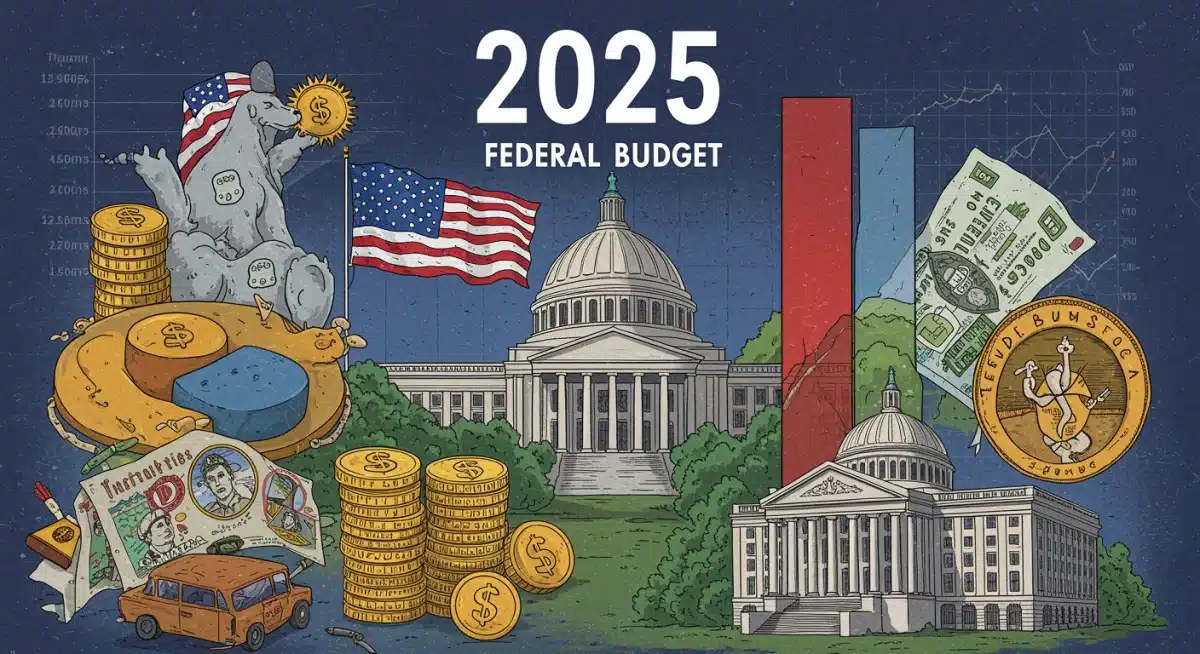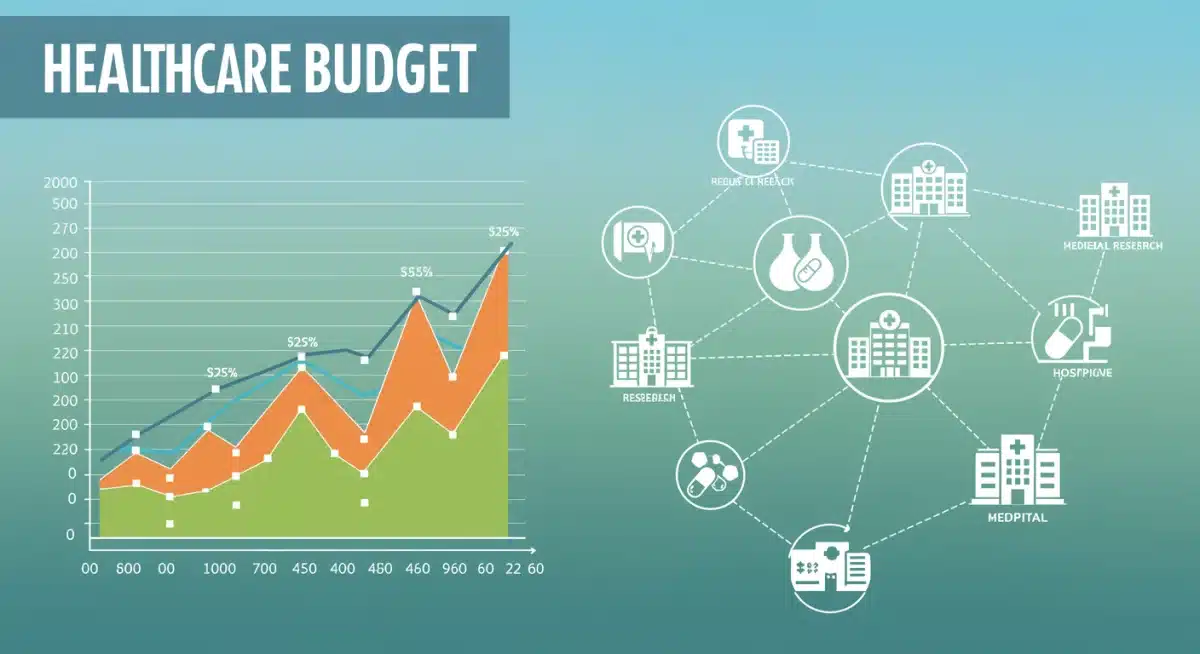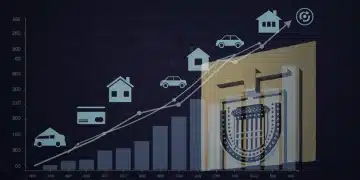2025 Federal Budget: Key Spending Shifts Affecting Americans

The 2025 federal budget introduces pivotal spending realignments impacting critical sectors like healthcare, education, and infrastructure, directly influencing the economic outlook for American citizens.
Understanding the intricacies of the 2025 federal budget is crucial for every American, as it directly influences daily life, from job prospects to healthcare costs and educational opportunities. This year’s budget proposes significant shifts in spending, promising both challenges and opportunities across various sectors.
Understanding the Budgetary Landscape for 2025
The federal budget serves as a comprehensive financial plan, detailing the government’s projected revenues and expenditures for the upcoming fiscal year. For 2025, this document reflects a complex interplay of economic priorities, social needs, and political considerations. It’s more than just numbers; it’s a blueprint for national direction, impacting everything from defense capabilities to social safety nets.
Each year, the budget process involves extensive negotiations and analyses, culminating in a proposal that often undergoes significant revisions before final approval. This year, the focus is sharply on strategic investments designed to bolster economic resilience and address pressing societal challenges. These investments are balanced against the need for fiscal responsibility and long-term sustainability.
Key Economic Assumptions
- Inflation Projections: The budget accounts for anticipated inflation rates, which influence the purchasing power of allocated funds and the cost of government programs.
- GDP Growth: Projections for Gross Domestic Product (GDP) growth are fundamental, as they determine the expected tax revenues available for government spending.
- Unemployment Rates: Forecasted unemployment figures impact spending on social welfare programs and workforce development initiatives.
The economic assumptions underpinning the 2025 budget are critical, as they dictate the flexibility and scope of proposed spending. Should economic conditions deviate significantly from these assumptions, the budget’s effectiveness and impact could be altered. Therefore, understanding these foundational forecasts is essential for grasping the budget’s potential implications.
In essence, the 2025 federal budget is a forward-looking document that attempts to navigate current economic realities while planning for future national needs. Its success hinges on a blend of accurate forecasting, strategic allocation, and effective implementation.
Major Shifts in Healthcare Spending and Policy
Healthcare remains a paramount concern for Americans, and the 2025 federal budget introduces substantial shifts aimed at both improving access and controlling costs. These changes will likely reverberate through insurance markets, hospital systems, and individual patient experiences. The budget emphasizes preventive care, mental health services, and pharmaceutical affordability, reflecting evolving national health priorities.
Significant allocations are directed towards strengthening public health infrastructure, particularly in light of recent global health challenges. This includes funding for disease surveillance, vaccine development, and emergency preparedness. The goal is to create a more resilient healthcare system capable of responding effectively to future crises.
Expanding Access to Care
- Medicaid Expansion: Continued federal support for states expanding Medicaid, aiming to cover more low-income individuals.
- Telehealth Services: Increased funding to make telehealth more accessible, especially in rural and underserved areas.
- Prescription Drug Costs: Initiatives to negotiate lower drug prices for Medicare beneficiaries and reduce out-of-pocket expenses for all Americans.
These policy shifts are designed to reduce barriers to healthcare, ensuring more Americans can access necessary medical attention without undue financial burden. The budget also proposes investments in healthcare workforce development, addressing shortages of doctors, nurses, and other medical professionals.
The proposed changes in healthcare spending are not without their critics, with debates centering on the balance between federal oversight and state autonomy, as well as the long-term fiscal implications. Nevertheless, the intent is clear: to foster a healthier nation through targeted investments and policy adjustments.
Education and Workforce Development Initiatives
Investing in education and workforce development is a cornerstone of the 2025 federal budget, recognizing the critical role these sectors play in national economic competitiveness and social mobility. The budget prioritizes initiatives from early childhood education to higher education and vocational training, aiming to equip Americans with the skills needed for a rapidly evolving job market.
A significant portion of educational funding is earmarked for programs that address learning gaps, particularly for disadvantaged students. This includes enhanced support for Title I schools, special education services, and initiatives designed to improve STEM (Science, Technology, Engineering, and Mathematics) education across all levels.

Higher Education and Student Aid
The budget proposes increases in Pell Grants, making higher education more affordable for low-income students. There are also provisions for student loan reforms, aiming to alleviate the burden of student debt and encourage greater participation in post-secondary education.
- Pell Grant Increases: Boosting the maximum Pell Grant award to help more students afford college.
- Student Loan Forgiveness Programs: Expanding eligibility and streamlining processes for existing loan forgiveness programs.
- Community College Funding: Investments in community colleges to offer more affordable and accessible vocational training programs.
Beyond traditional education, the budget also focuses on workforce development programs. These initiatives aim to reskill and upskill workers in industries facing technological disruption, ensuring a robust and adaptable labor force. This includes funding for apprenticeships, job training programs, and career counseling services.
The emphasis on education and workforce development underscores a commitment to long-term economic growth and individual prosperity. By investing in human capital, the 2025 federal budget seeks to create a more equitable and competitive society.
Infrastructure and Climate Resilience Projects
The 2025 federal budget allocates substantial funds to infrastructure development and climate resilience, recognizing these areas as vital for national progress and environmental protection. These investments are designed to modernize America’s aging infrastructure, create jobs, and mitigate the impacts of climate change.
Key infrastructure projects include upgrades to roads, bridges, public transit systems, and airports. The budget also emphasizes expanding broadband internet access to underserved communities, bridging the digital divide and fostering economic opportunity in rural areas. These investments are expected to enhance connectivity and efficiency across the nation.
Addressing Climate Change
Climate resilience is another major focus, with funding directed towards renewable energy initiatives, energy efficiency programs, and projects aimed at protecting communities from extreme weather events. The budget supports research and development in clean energy technologies, positioning the U.S. as a leader in the global transition to a sustainable economy.
- Renewable Energy Incentives: Tax credits and grants for solar, wind, and other clean energy projects.
- Coastal Protection: Funding for projects to safeguard coastal communities from rising sea levels and storm surges.
- Grid Modernization: Investments to upgrade the national power grid, making it more resilient and capable of handling renewable energy sources.
These infrastructure and climate resilience projects are not merely about physical improvements; they represent a strategic vision for a more sustainable and economically robust future. They are expected to generate significant economic activity, creating jobs and stimulating innovation across various sectors.
The budget’s commitment to these areas reflects a growing understanding of the interconnectedness between economic prosperity, environmental health, and national security. It’s a forward-looking approach to building a more resilient and competitive America.
Defense and National Security Priorities
National security remains a top priority in the 2025 federal budget, with significant allocations for defense spending, cybersecurity, and global diplomatic efforts. The budget aims to maintain a strong military presence, deter potential adversaries, and protect American interests both at home and abroad.
Investments in defense modernization include funding for advanced weapons systems, research and development in emerging technologies, and improvements to military readiness. The goal is to ensure the U.S. military remains at the forefront of global defense capabilities, capable of responding to a wide range of threats.
Cybersecurity Initiatives
Given the increasing sophistication of cyber threats, the budget significantly boosts funding for cybersecurity programs across government agencies. This includes enhancing defenses against cyberattacks on critical infrastructure, protecting sensitive data, and fostering a skilled cybersecurity workforce.
- Cyber Defense Upgrades: Modernizing federal IT systems and infrastructure to better withstand cyber threats.
- Intelligence Gathering: Increased funding for intelligence agencies to monitor and counter evolving global threats.
- International Partnerships: Strengthening alliances and diplomatic efforts to address shared security challenges.
Beyond traditional defense, the budget also supports diplomatic initiatives aimed at promoting peace and stability around the world. This includes foreign aid, humanitarian assistance, and engagement with international organizations to address global challenges such as poverty, disease, and conflict.
The defense and national security allocations in the 2025 budget reflect a comprehensive approach to protecting American interests, combining military strength with diplomatic engagement and technological innovation. It’s about securing the nation in an increasingly complex global landscape.
Social Safety Nets and Support Programs
The 2025 federal budget reaffirms the government’s commitment to supporting vulnerable populations through various social safety nets and support programs. These initiatives are designed to provide a crucial lifeline for millions of Americans, addressing issues such as poverty, food insecurity, and housing instability.
Significant funding is allocated to programs like Social Security, Medicare, and Medicaid, which form the bedrock of America’s social safety net. The budget aims to ensure the long-term solvency of these programs while also improving their efficiency and responsiveness to beneficiary needs.
Targeted Assistance Programs
Beyond the major entitlement programs, the budget also targets specific areas of need. This includes increased funding for affordable housing initiatives, food assistance programs like SNAP (Supplemental Nutrition Assistance Program), and childcare subsidies to support working families.
- Housing Assistance: Expanding rental assistance programs and investing in the creation of more affordable housing units.
- Food Security: Strengthening programs that combat food insecurity and ensure access to nutritious meals for all Americans.
- Childcare Support: Providing subsidies and expanding access to high-quality childcare, easing financial burdens on parents.
The budget also proposes investments in programs that support individuals with disabilities, veterans, and those experiencing homelessness. These initiatives aim to provide comprehensive support, enabling individuals to achieve greater independence and participate fully in society.
The focus on social safety nets and support programs in the 2025 budget underscores a commitment to social equity and the well-being of all Americans. It reflects a belief that a strong society is one that cares for its most vulnerable members.
Economic Impact and Future Outlook for Americans
The 2025 federal budget is poised to have a profound economic impact on Americans, shaping everything from individual finances to broader market trends. The proposed spending shifts and revenue projections will influence inflation, interest rates, employment figures, and investment opportunities across various sectors.
Increased government spending in areas like infrastructure and clean energy is expected to stimulate economic growth and create new jobs. These investments can lead to a multiplier effect, where initial spending generates further economic activity, benefiting businesses and workers alike. However, the exact magnitude of this impact will depend on implementation efficiency and market responsiveness.
Potential Economic Challenges
While the budget aims for positive economic outcomes, potential challenges remain. Concerns about national debt, inflationary pressures, and global economic uncertainties could influence the budget’s effectiveness. Navigating these challenges will require careful fiscal management and adaptive policy responses.
- Inflationary Pressures: Large government spending can sometimes contribute to inflation, impacting consumer purchasing power.
- National Debt: The long-term implications of increased national debt on future generations and fiscal stability.
- Global Economic Volatility: External economic factors, such as international trade relations and geopolitical events, can influence the budget’s outcomes.
For individual Americans, the budget’s impact will be felt through changes in taxes, access to social services, and the availability of job opportunities. For example, tax adjustments or expanded eligibility for certain programs could directly affect household budgets.
Looking ahead, the 2025 federal budget sets a course for the nation’s economic future. Its success will be measured not only by its immediate effects but also by its ability to foster sustainable growth, enhance national well-being, and adapt to unforeseen challenges.
| Key Area | Budgetary Shift |
|---|---|
| Healthcare Spending | Increased focus on preventive care, mental health, and prescription drug affordability, expanding access to services. |
| Education & Workforce | Enhanced Pell Grants, student loan reforms, and significant investments in vocational training and STEM education. |
| Infrastructure & Climate | Modernization of roads, bridges, public transit, broadband expansion, and significant clean energy incentives. |
| Defense & National Security | Funding for defense modernization, cybersecurity enhancements, and global diplomatic efforts to protect national interests. |
Frequently Asked Questions About the 2025 Federal Budget
The primary goals of the 2025 federal budget include fostering economic growth, strengthening national security, improving healthcare access and affordability, advancing education and workforce development, and investing in critical infrastructure and climate resilience projects across the nation.
The budget aims to reduce healthcare costs through initiatives like negotiating lower prescription drug prices, expanding Medicaid, and increasing access to preventive care and telehealth services. These measures are designed to ease financial burdens on patients and improve overall affordability.
Yes, the 2025 federal budget proposes increases in Pell Grants to make higher education more accessible. It also includes provisions for student loan reforms, aiming to alleviate debt burdens and encourage more Americans to pursue post-secondary education and vocational training.
Priority infrastructure projects include upgrades to roads, bridges, and public transit. The budget also focuses on expanding broadband internet access to underserved communities and investing in renewable energy and climate resilience initiatives to modernize national infrastructure and promote sustainability.
The budget allocates significant funds to defense modernization, including advanced weapons systems and cybersecurity enhancements. It also supports intelligence gathering and strengthens international partnerships, aiming to protect American interests and respond effectively to evolving global security challenges.
Conclusion
The 2025 federal budget represents a strategic document poised to reshape various facets of American life. From substantial investments in healthcare and education to critical advancements in infrastructure, climate resilience, and national security, the budget reflects a concerted effort to address present challenges while building a more prosperous and secure future. While the implementation and outcomes will unfold over time, understanding these key spending shifts is vital for every American to navigate the evolving economic and social landscape effectively.





